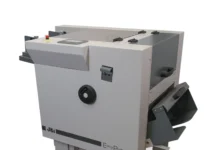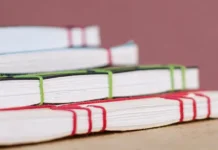by Anna Massey, director of marketing, Gateway Bookbinding Systems

Plastic spiral binding is a common and popular binding choice for all types of printed projects. In addition to being the binding of choice for reports, school agendas and cookbooks, spiral binding often is determined to be the best choice for thicker projects with 250 or more sheets. Coil binding allows these thicker projects to be open cover-to-cover while lying flat. For something that thick, this is a particularly nice feature.
There are, however, some unique challenges involved when coil binding a book that measures one inch or thicker. One of the most important variables that can – and often does – affect the ability to insert coil into a book of that size is the size of the punch hole being used. It is not uncommon for customers to have smaller, 4mm round 4:1 pitch (four holes per one inch) punch dies. Then, they attempt to insert a 45 or 50mm diameter coil through those smaller holes.
When it comes to binding thicker books, consider changing to a wider punch pitch with a larger oval-shaped hole. For instance, a 3:1 or 2.5:1 spacing would best fit a 6.5×5.5mm oval hole. It’s a simple equation – the larger the punch hole, the easier the coil will be able to find its way through.
 As the coil is inserted into the thick block of paper that will become the book, the book will start to curve as it follows the curve of the coil. As a result, the “window” that is the punch hole begins to reduce. The smaller the punch hole, the quicker that window closes. With a large oval hole and wider pitch, the additional height of the hole provides a larger window for the coil to find its way.
As the coil is inserted into the thick block of paper that will become the book, the book will start to curve as it follows the curve of the coil. As a result, the “window” that is the punch hole begins to reduce. The smaller the punch hole, the quicker that window closes. With a large oval hole and wider pitch, the additional height of the hole provides a larger window for the coil to find its way.
Working with a wider pitch and a larger oval punch hole on thicker books is recommended for all types of coil inserters. Whether working with tabletop roller inserters, wheel drive machines or an automated system, utilizing these suggestions can improve productivity as much as 50 percent.

For those who don’t have the ability to punch with a wider pitch, another option is the PLASTIKOIL Binding Stick. The PLASTIKOIL Binding Stick is a clear plastic stick with a shepherd’s hook on one end. It allows multiple coil bound sections to be combined so they can be used and stored as a single book. For example, a very thick book is divided into two equal sections. Each section is coil bound, and then the sections are stacked on top of each other with the coil overlapping slightly. The binding stick slides between the overlapping rows of coil and locks into place to provide a strong, nearly invisible binding link. The PLASTIKOIL Binding Stick is ideal for combining volumes, addendums, price lists or catalogs.
As one of the most popular and fastest growing styles of binding, spiral binding offers a number of advantages for binders and their customers. Not only are spiral-bound documents able to lay flat, but the pages also are able to turn a full 360 degrees around the flexible spine. Furthermore, with more than 60 colors available, spiral binding offers the greatest range of colors of any other binding style. Even thicker books can be bound using colored coils. The important thing to remember when binding thicker projects is to select an appropriately size punch hole.
Anna Massey is the director of marketing at Gateway Bookbinding Systems. With over 30 years of experience in the industry, she is very familiar with the product and the process of plastic spiral binding. For more information, visit www.plastikoil.com.




